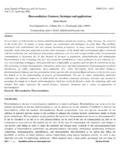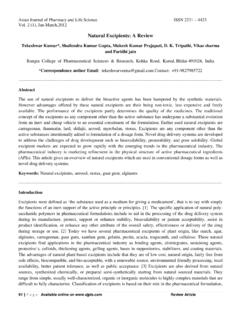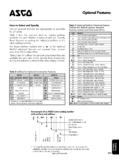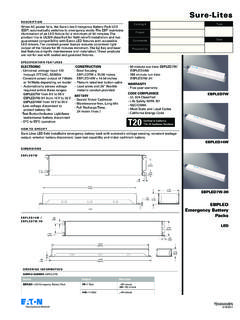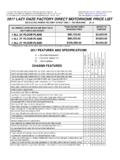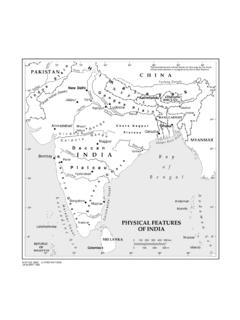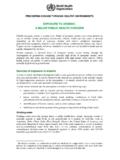Transcription of Bioremediation: Features, Strategies and applications
1 Asian Journal of Pharmacy and Life Science ISSN 2231 4423. Vol. 2 (2), April-June,2012. bioremediation : Features, Strategies and applications Shilpi Sharma*. Post Graduate Govt. College, Sec-11, Chandigarh, India-160014. Corresponding author's Email: ---------------------------------------- ---------------------------------------- ---------------------------------------- --------------------- Abstract In early times, we believed that we had an unlimited abundance of land and resources; today, however, the resources in the world show, in greater or lesser degree, our carelessness and negligence in using them.
2 The problems associated with contaminated sites now assume increasing prominence in many countries. Contaminated lands generally result from past industrial activities when awareness of the health and environmental effects connected with the production, use, and disposal of hazardous substances were less well recognized than today. Environmental contamination is increasing day by day because of increase in population, industrialization and urbanization bioremediation is the technology that uses microorganism metabolism to remove pollutants it uses relatively low- cost, low-technology techniques, which generally have a high public acceptance and can often be carried out on site.
3 This technology includes biostimulation (stimulating viable native microbial population), bioaugmentation (artificial introduction of viable population), bioaccumulation (live cells), biosorption (dead microbial biomass), phytoremediation (plants) and rhizoremediation (plant and microbe interaction).Rapid advances in the last few years has helped us in the understanding of process of bioremediation . The use of culture independent molecular techniques has definitely helped us to understand the microbial community dynamics, structure and assisted in providing the insight in to details of bioremediation which has surely facilitated to make the technology safer and reliable.
4 This paper represents the special features, Strategies , limitation and a variety of approaches of bioremediation . Keywords: bioremediation , Phtyoremediation . ---------------------------------------- ---------------------------------------- ---------------------------------------- ----------------- Introduction bioremediation is the use of microorganism metabolism to remove pollutants. bioremediation can occur on its own (natural attenuation or intrinsic bioremediation ) or can be spurred on via the addition of fertilizers to increase the bioavailability within the medium (biostimulation).
5 Recent advancements have also proven successful via the addition of matched microbe strains to the medium to enhance the resident microbe population's ability to break down contaminants. Microorganisms used to perform the function of bioremediation are known as bioremediators[1]. It can be classified as in situ or ex situ . bioremediation can be used at the site of contamination (in situ) or on contamination removed from the original site (ex situ). In the case of contaminated soil, sediments, and sludges, it can involve land tilling in order to make the nutrients and oxygen more available to the examples of bioremediation technologies are phytoremediation, bioventing, bioleaching, landfarming, bioreactor, composting, bioaugmentation, rhizofiltration, and biostimulation.
6 bioremediation is an option that offers the possibility to destroy or render harmless various contaminants using natural biological activity. As such, it uses relatively low-cost, low-technology techniques, which generally have a high public acceptance and can often be 202 | P a g e Available online on Review Article Asian Journal of Pharmacy and Life Science ISSN 2231 4423. Vol. 2 (2), April-June,2012. carried out on site. It will not always be suitable, however, as the range of contaminants on which it is effective is limited, the time scales involved are relatively long, and the residual contaminant levels achievable may not always be appropriate.
7 Although the methodologies employed are not technically complex, considerable experience and expertise may be required to design and implement a successful bioremediation program, due to the need to thoroughly assess a site for suitability and to optimize conditions to achieve a satisfactory result. The conventional techniques used for remediation have been to dig up contaminated soil and remove it to a landfill, or to cap and contain the contaminated areas of a site. The methods have some drawbacks. The first method simply moves the contamination elsewhere and may create significant risks in the excavation, handling, and transport of hazardous material.
8 Additionally, it is very difficult and increasingly expensive to find new landfill sites for the final disposal of the material. The cap and contain method is only an interim solution since the contamination remains on site, requiring monitoring and maintenance of the isolation barriers long into the future, with all the associated costs and potential liability. A better approach than these traditional methods is to completely destroy the pollutants if possible, or at least to transform them to innocuous substances.
9 Some technologies that have been used are high-temperature incineration and various types of chemical decomposition ( , base-catalyzed dechlorination, UV oxidation). They can be very effective at reducing levels of a range of contaminants, but have several drawbacks, principally their technological complexity, the cost for small-scale application, and the lack of public acceptance, especially for incineration that may increase the exposure to contaminants for both the workers at the site and nearby residents.
10 Principle of bioremediation :- bioremediation is defined as the process whereby organic wastes are biologically degraded under controlled conditions to an innocuous state, or to levels below concentration limits established by regulatory authorities [2] For bioremediation to be effective, microorganisms must enzymatically attack the pollutants and convert them to harmless products. As bioremediation can be effective only where environmental conditions permit microbial growth and activity, its application often involves the manipulation of environmental parameters to allow microbial growth and degradation to proceed at a faster rate.
